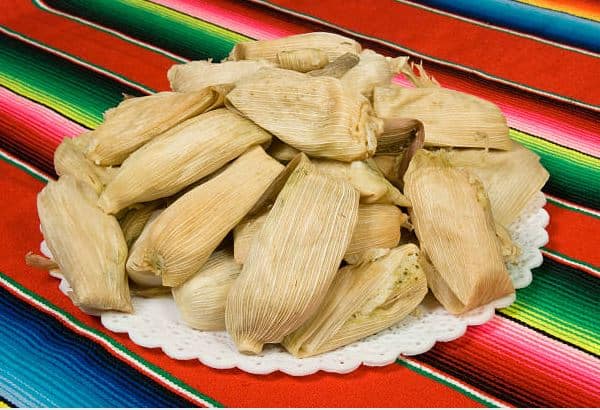Tamales! This enduringly popular Mesoamerican meal made from masa, a maize dough, is a traditional part of Central American cuisine and has been enjoyed as far back as the first century AD.
In order to enjoy them for longer, we’ve compiled a series of the most popular questions to do with keeping this favorite food fresh, delicious, and safe to consume at home.
Today – tamales can be filled with a range of culinary delights: meats, cheeses, vegetables, and chilies, seasoned, then steamed in a corn husk or banana leaf for a spongy, moreish texture and flavorsome finish.
Often made in batches, you might be expecting tamales to spare. Or perhaps you’re looking to prepare an amount in advance for later consumption.

If so, you’ll want to know the correct amount of time that your tamales stay in tip-top, tasty, safe-to-eat shape – but how long do tamales last in the fridge? And can you freeze tamales?
With their proclivity for fresh fillings, it’s often recommended that you cook them first before storing them – in that case, how long do cooked tamales last?
We’re here to help, as we answer all these questions and many more. So, how long do tamales last?
Table Of Contents:
How Long Do Tamales Last In the Fridge?
Ok! We’re getting into the meat (or cheese) of this article now, but before we answer the question at hand we’ll have to look at some all-important food safety rules.
How long do tamales last outside?
It’s recommended that any foods left on the counter should be refrigerated within two hours, and cooked tamales themselves will keep for around 1-2 hours prior to refrigeration. You should try to get them into the fridge as soon as possible – allowing them to come down to room temperature first – as this will reduce the chance of harmful bacterial growth.
Uncooked tamales should go into the fridge immediately after preparation, and not be left out for more than an hour as their fresh ingredients are more susceptible to bacterial growth.
Why should I wait until my tamales have cooled before freezing?
But why do we have to wait until they cool to room temperature? Well, this common culinary wisdom has food safety credence. On the surface, it seems you should put your tamales into the fridge as soon as possible in order to speed up cooling, but the truth is that you absolutely should wait.
This is because the delicate climate of your refrigerator, which must stay at the right temperature to keep food fresh, can be easily influenced by the introduction of hot food. Even with the most advanced of fridges, it’s not worth the risk of making your previously stored foods unstable.
So – back to the question at hand, how long do tamales last in the fridge? Both cooked and uncooked, tamales last for around a week in a normal refrigerator.
Tamales, cooked or uncooked – up to 1 Week, refrigerated in a zip lock bag or sealed container.
Quick Tip: What is the best way to Store Tamales?
In order to keep them in their best condition, make sure they’re tightly wrapped in aluminum foil or placed in a zip lock bag or sealed container. Air encourages food spoilage, so we’re looking to limit contact as much as possible.
If they’re stacked on top of each other and not wrapped in foil, place napkins between them as this will help to collect fluid and keep your tamales texture firmer for longer.
back to menu ↑
How Long Do Tamales Last In the Freezer?
But can you freeze tamales? Absolutely. As with all foods, home freezing is an effective way to keep produce stable for longer. So how long do tamales last in the freezer?
Tamales will last for up to six months in a normal freezer – again, make sure that they are cooled down to room temperature before wrapping and storing. The sooner you can take them out the better, both flavor and texture quality will reduce over time.
Tamales, cooked or uncooked – 6 Months Frozen in a sealed container.
As a general rule, we’d recommend freezing tamales after cooking. The freezing process can have some unwanted effects on the uncooked dough, and while they’re absolutely food safe for up to six months, your tamales will retain their structural integrity much more effectively if cooked prior to freezing. We can’t have our tamales falling apart now, can we?
How do you know if Tamales are bad?
Aside from the typical tell-tale sign of mold – which emerges on tamales as dark green or grey spots – you’ll be able to tell by scent. If there is a sour or rotten smell to your tamales then throw the whole lot into the garbage.
Don’t risk trying to sift out the seemingly safe ones as the chance of cross-contamination is high.
Make sure you dispose of the packaging and wash your hands afterward. Any containers used – and their lids – should be thoroughly washed with antibacterial soap while wearing gloves.
back to menu ↑
Are Pork Or Chicken Tamales Better?
In terms of taste – we’ll leave the choice entirely in your hands. Both are delicious options for carnivorous consumers.
Pork and chicken play well with different flavors once shredded, as it increases the surface area of that all-important sauce – consider a slow-cooked broth with chilies and Mexican spices, with plenty of cooling salsa as an accompaniment.
And how good are they for you? Tamales in general are seen as fairly healthy. They’re steamed, not fried, and so typically have a lower fat content. Then there are your fillings – stuffing them with red meats and rich cheeses may not be the most heart-healthy option, chicken is better in this regard, but in their versatility, they work great with vegetables as well.
There’s also a fair amount of carbohydrates in the masa dough, but it’s much more fiber-rich than other sources.
How long are homemade pork tamales good for?
In terms of shelf life? As long as they are properly frozen, pork tamales should last up to six months, but to be on the safe side we’d recommend removing them after four.
Meats, though delicious, can encourage all kinds of nasty bacterial growths if not properly stored. Chicken in particular is infamous for proliferating salmonella, and trichinosis, caused by eating undercooked pork, is also a concern – although cases have reduced in modern times.
If you’re wondering how long your tamales will last with a manchego cheese filling – here’s another of our articles on just that!
back to menu ↑
3 Best Ways To Reheat Tamales?

First and foremost, you’ll want to make sure your tamales are cooked completely in the initial steaming. Then once removed from the freezer, make sure they are frozen properly and allow them to thaw in the refrigerator. Let’s get to reheating!
1) In the Microwave
The microwave – that ever-versatile kitchen contraption. It’s a fast, reliable way to reheat anything, but remember that you’ll probably get better results – texturally at least from our other two methods.
Nothing beats the microwave for efficiency and speed, however. Simply let your tamales spin for one to two minutes on a microwavable plate until warm.
It’s also recommended that you wipe them down with a wet paper towel as this will help improve their texture as they heat up.
2) In the Oven
The oven typically has better results for texture and you’ll want to wrap your tamales in aluminum foil to stop them from drying out.
Allowing enough space between them, lay your tamales into a dish and cook for 20-25 minutes – flipping once during cooking at a temperature of 325 degrees Fahrenheit/170 degrees Celsius.
3) Using a Steam Basket
Steaming is the classic way in which tamales are cooked and with that equipment on hand, you can also easily reheat them. It provides the best possible texture but requires a little more time and prep work.
Pour water into your pan, making sure the bottom is covered and the liquid rises a couple of inches up the side. Then, place your steamer basket into the water and bring the pot to a boil. Once bubbling, carefully place your tamales into the pot (tongs are the safest way to do this).
Turn your burner down to medium, and let your tamales steam for 30 minutes if frozen and 10 if straight out of the fridge.
back to menu ↑
The Final Words
There you have it – how to keep, freeze, and reheat your tamales, safely, quickly, and ideally with that all important texture intact.
We hope we’ve covered everything, and if you’re new to this hearty, versatile Mesoamerican dish then we’d absolutely recommend that you try making them at home.
If you’d rather leave it to the experts, go ahead and order from your favorite Mexican take-out. Although, it won’t surprise you to know that in their enduring popularity, tamales have become a favorite food of many cultures, with delicious variations stretching across the Spanish-speaking world – into Asia with the Philippines and Guam, and of course the United States.
So, have a look! Find a place where they’re on the menu and try a tantalizing tamale or three for yourself. You’ll certainly know what to do with the leftovers!
Shanny
Shanny not only has an exceptional understanding of the foodie mindset and how nutrition works, she has also achieved her Master’s Degree in Education. Outside of her academic achievements, she loves writing food blogs. It's so much more than a list of meals though! Shanny creates helpful cookware guides and delicious recipes that are easy to follow. She does all of this as a food blog writer because she loves it. That's why she spends lots of time testing out different recipes in her own home. She truly is a one-of-a-kind foodie, from her home to yours - with a story to tell, new recipes to indulge in and new tips to tantalize those tastebuds.












